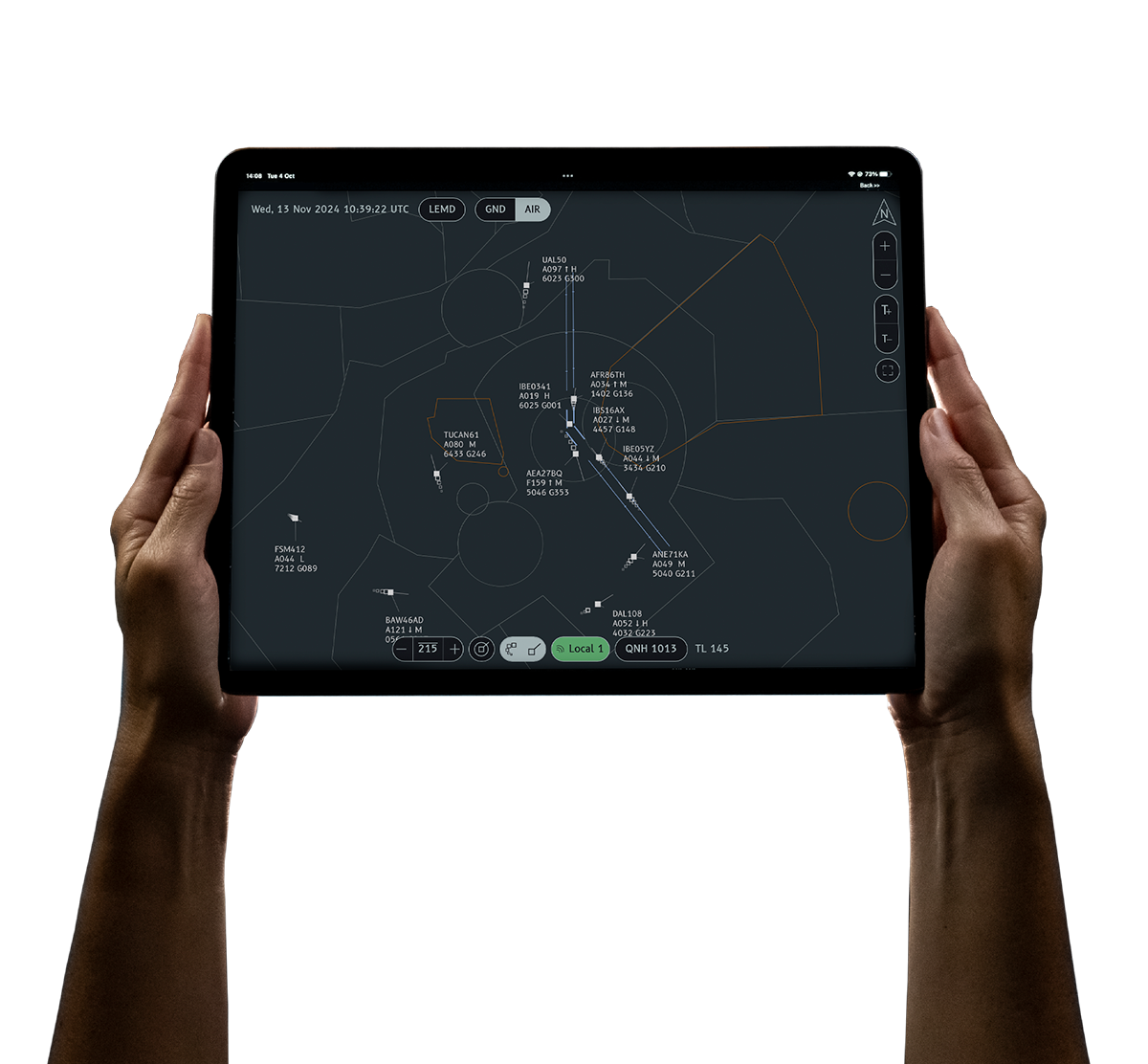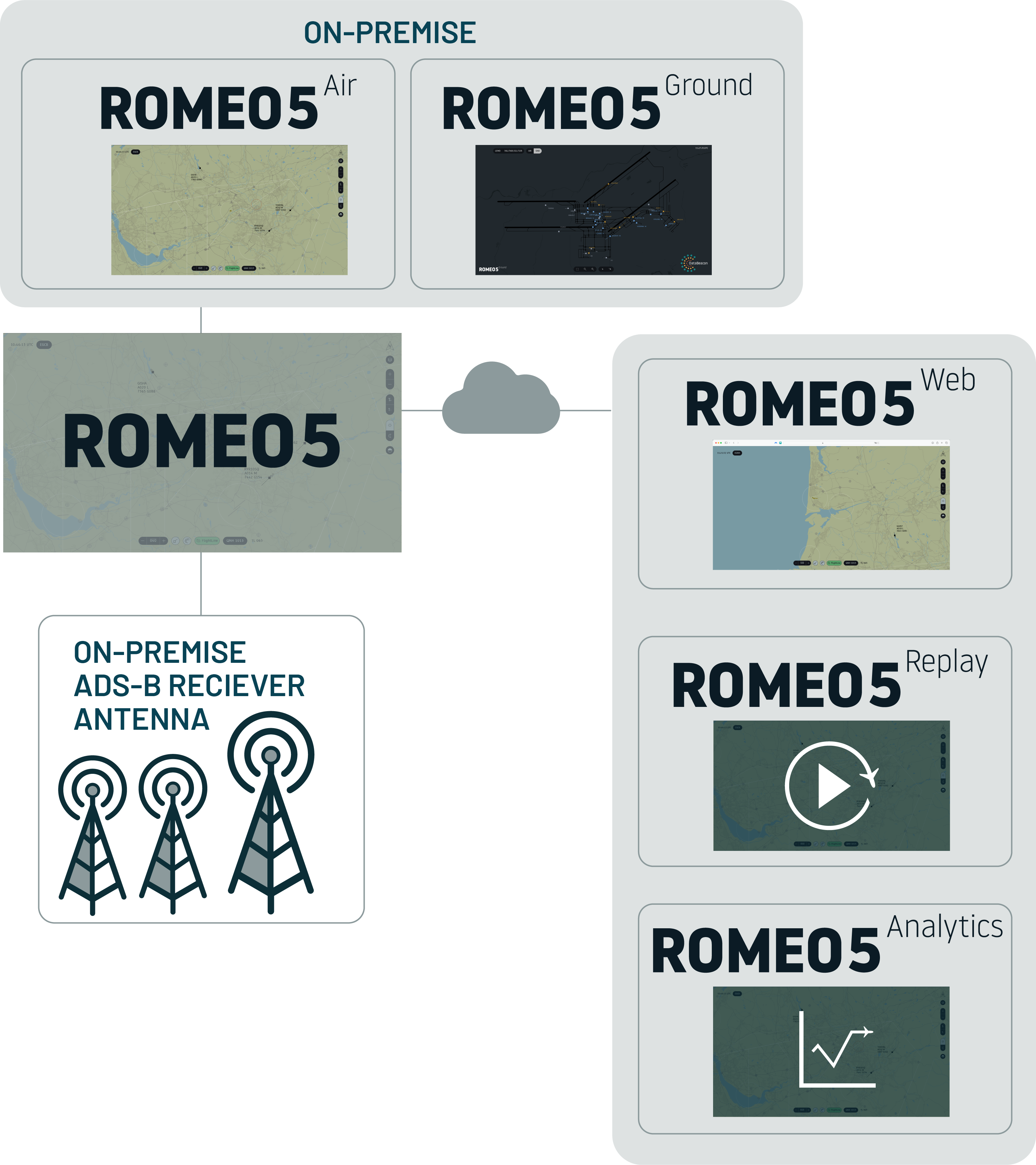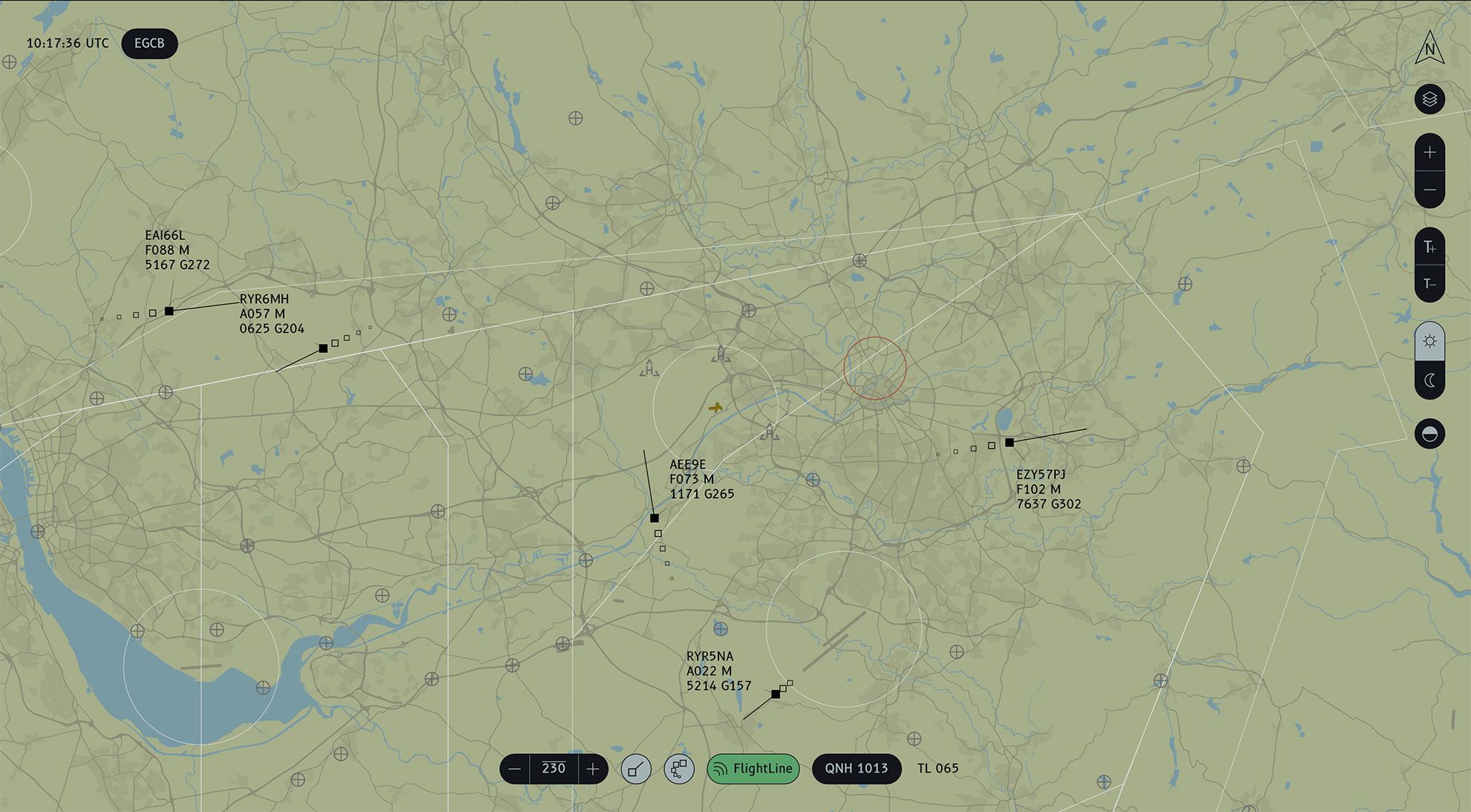ROMEO5 Air
Flight Information Display
and Situational Awareness
for ATC and AFIS


Enhanced situational awareness
Romeo5 Air enables the ATCO or AFISO to have a greater knowledge of airborne activity within the vicinity. This can assist with workload reduction, as a greater understanding of the traffic situation can be obtained.

Cloud and on-premise
Flexible deployment as a local and cloud-based web app, ensuring uninterrupted operations and robust backup in any scenario. Both cloud and on-premise, simultaneously or alternatively, Romeo5 ensures uninterrupted access to critical data.

Recording and Playback
Romeo5 offers a 30-day video playback feature for easy incident investigation or analysis. Additionally, our optional cloud-based replay tool, Bravo5 provides unlimited playback access to all recorded cloud data.

ADS-B data resilience
Romeo5 maximises accuracy and reliability by merging data from multiple ADS-B feeds. It can tap into sources like the uAvionix Flightline MASS network for seamless traffic monitoring. Users can switch between local or cloud data sources and visually track which ones are in use.

Safe and cost-effective
Once running, the FID requires very little service/maintenance. For units where a FID may be a future replacement to traditional radar systems, this can provide large cost savings in ongoing costs of maintaining such equipment.

Customisable and user-friendly
The user-friendly and intuitive system with customisable features allow Romeo5 Air to be tailored to meet the specific needs of the service provider. Mapping, target and label display options and user defaults can be customised.

Real-time Data
Romeo5’s ability to process vast amounts of real-time data ensures efficient handling of all air traffic and data demands with ease. Position data of aircraft or vehicles ‘target’ positions is updated approximately every second.

Ease of installation
The Romeo5 is designed for easy setup. Its FID comes pre-configured, ready to deploy with minimal antenna installation required. DataBeacon assists with final configuration. Additional items like screens, keyboards, and cables are not included, allowing users to choose what suits their needs and budget.
ROMEO5 Air is an ATM-grade Flight Information Display (FID) solution which is able to display aircraft position targets in real-time. This provides Air Traffic Control Officers (ATCOs) or Aerodrome Flight Information Service Officers (AFISOs) with the ability to have enhanced situational awareness of activity on and around an aerodrome, and provision of generalised traffic information to aircraft on frequency. In line with permitted use,
it shall not be used for the provision of air traffic separation.
By leveraging ADS-B (and FLARM) technology, it seamlessly receives data from aircraft transponders, providing pilots with real-time insights into their surroundings. With features like
QNH correction and UL data integration, ROMEO5 AIR ensures precise positioning and awareness, reducing the risk of
mid-air incidents. Perfectly compatible with ROMEO5 GND, this system offers a seamless fit for airports looking to integrate air and ground operations.
DataBeacon has been at the forefront of aviation safety solutions, and ROMEO5 AIR reflects our commitment to cost-effective, high-impact technology. Whether you’re managing a busy hub or a regional airport, ROMEO5 AIR delivers the clarity pilots need—backed by our continued support and flexible delivery schedules.
Ready to elevate your air operations?
Contact us for a demo today.
Romeo5 FID can be successfully implemented worldwide.
In the UK, Romeo5 is compliant with CAA CAP670 demands.
This encompasses the crucial aspect of correcting altitude
based on local QNH, in accordance with CAA regulations.
While DataBeacon does not directly provide approval services, we are committed to providing all necessary information related to CAP670 compliance to support Safety Case development.
In the event of any software issues that require adjustments for approval, DataBeacon will promptly provide updates as needed to ensure seamless acceptance.
Data is received from various sources (ADS-B/FLARM*) into a single platform, which provides a comprehensive and unified view of the surrounding airspace. Additionally, browser based access of the FID is also provided, allowing for other monitoring and information away from operational positions.
The FID runs on a single, pre-configured standalone small form factored PC, which can be connected to a monitor of your choice. Multiple FID units can be provided for redundancy.
ROMEO5 is also offered with an optional cloud data feed to provide the ultimate multiple redundancy and data validation for the FID. Further information is available on request.
(*FLARM reception optional)

Targets and Labels
Romeo5 Air effectively positions aircraft on the map and
generates labels containing pertinent information such as callsign/registration, altitude/flight level (corrected for QNH),
ground speed, squawk and has the capability to incorporate the aircraft wake turbulence category and if the targets are UAVs or helicopters (HEL) on the second line of the label. Moreover, it makes a distinction between traffic squawking emergency codes and instances where updates are not received from the ADS-B antenna (FRZ or frozen).
To avoid overlapping, the labels are automatically positioned using
an intelligent label avoidance algorithm. To further refine the understanding of traffic dynamics, Romeo5 Air includes a selectable historical trail for each aircraft.
Pre-set and selectable altitude/level filters are available to remove unwanted targets outside the service area.
Control Elements
The system incorporates a range of intuitive control elements, aligning with best practices in the industry, and CAP 670 regulations. Users have the capability to zoom the map and labels independently, providing a customisable display that caters to specific operational requirements.
The system also prioritises contrast for optimal visibility, ensuring that displayed information remains clear and discernible in various ambient lighting conditions. In instances where multiple antennas and/or cloud are deployed, the system allows for seamless antenna selection, providing flexibility and control over the data sources used for enhanced precision.
Maps and Layers
The mapping functionality within Romeo5 Air is designed to
align with the stringent standards, ensuring accuracy and compliance in displaying critical flight information. During the design phase, we offer a high degree of customisation, empowering them to tailor the map orientation to either the North or align it with the perspective as seen from the tower window. This adaptability caters to individual preferences, providing a client- centric interface for enhanced operational efficiency.
Moreover, during design, the system offers comprehensive customisation options, enabling clients to personalise maps
by incorporating essential details such as fix points, airways,
visual reference points, VFR corridors, and any other topographic pertinent features. This level of customisation fosters a tailored user experience, streamlining the identification and tracking of
specific locations in the vicinity of the airport.
Romeo5 Air further enhances its versatility with the integration
of customisable layers. Users can selectively activate or deactivate layers to display different elements, names of fix points or populations, restricted areas, SIDs or STARs. This layering capability ensures that the displayed information is contextually relevant and aligns precisely with the operational needs of the users.
Pricing
Delivery Schedule
We provide an estimated schedule to deliver the system within 8 weeks, which includes all elements of customization, internal testing, acceptance testing, shipping, and necessary mapping customizations to ensure the system is fully functional upon delivery. Our design process ensures that the final system is first deployed on a web environment for approval, simplifying feedback from our customers and ensuring
deadlines are met.
FAQs:
Romeo5 has been designed specifically for use by ATC and AFIS to enhance situational awareness. It provides reliability and accuracy of information displayed. The display is designed to be user focussed, with clear non overlapping labels and adjustable day/night and brightness levels. Romeo5 displays data received from dedicated receiver(s), ensuring full integrity of data and also includes QNH Altitude/Level conversion.
Romeo5 is able to receive any transmitted ADS-B data via a number of available receivers. Such ADS-B may be received from aircraft, ground vehicles and UAVs. In certain antenna configurations it is also able to receive and display FLARM data.
In the UK and the USA it is also compatible with uAvionix Managed Airspace Surveillance Service providing additional data integrity, enhanced coverage and redundancy.
The FID allows the user to select the actively used data sources and provides clear indication of the active status of each source.
Romeo5 has been designed to meet or exceed the requirements within CAA CAP670 requirements, and is declared as compliant by DataBeacon.
Romeo5 is designed and tailored for the specific requirements of the airport. Local mapping with airspace and other required layers is included and configured during the initial setup, with future updates included.
Each target can display Callsign/Registration, Altitude/Level, Speed, Heading, Squawk, Type Code. History Trailers and predict vector lines are also available.
Yes, Romeo5 offers the flexibility to be run both locally and in a cloud environment as a native web application, providing a robust backup or mobile contingency system. This local setup ensures uninterrupted operations and immediate access to critical data even in the event of internet connectivity issues or other external disruptions.
All data is retained for a period of 30 days, allowing playback and export of any period. Optionally, we offer a data cloud-based replay tool with unlimited storage capability.
Romeo5 has been designed to be a cost-effective alternative to expensive radar systems. Romeo5 runs on a simple dedicated hardware device and requires only simple antenna installation to become operational. The system, once running requires very little to no ongoing engineering input. This enables Romeo 5 to be adaptable to suit all scale of service provider.
From commencement of an agreement, we are able to complete all customisation, prepare, test and deliver Romeo5 to you within a timescale of 6-8 weeks.
Throughout the contract period, Romeo5 is supported by the dedicated DataBeacon support team, who will provide comprehensive hardware/software and user support as required. All change requests to mapping are included.
